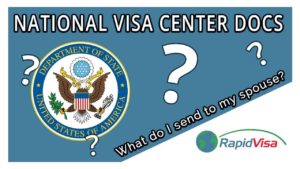How to meet the U.S. government's financial sponsorship requirements
The most common minimum annual income required to sponsor a spouse or family member for a green card is $21,775. This assumes that the sponsor — the U.S. citizen or current green card holder — is not in active military duty and is sponsoring only one relative.
The income requirements increase based on family size, as shown in the tables below. The amounts will also be higher for residents of Alaska and Hawaii than for residents of the 48 contiguous states, the District of Columbia, and U.S. territories.
Minimum Income Requirements
In order for a relative to qualify for a green card, the sponsor must accept financial responsibility. For more information about the sponsor's financial obligation, check out our guide to the Affidavit of Support (Form I-864).
Note: For marriage green cards, the minimum income requirements are the same for couples who both live outside of the United States, so these couples should follow the guidelines below for the 48 contiguous states, D.C., and U.S. territories.
RapidVisa takes your green card application forms, including the Affidavit of Support, and turns them into simple questions you can answer online — typically in under two hours.
| 2021 Minimum Annual Income Requirements for Most Sponsors: 125% of Federal Poverty Guidelines | |||
|---|---|---|---|
| Number of people in your household (including yourself and your spouse)* | For sponsors in the 48 contiguous states, D.C., and U.S. territories | For sponsors in Alaska | For sponsors in Hawaii |
| 2 | $21,775 | $27,212 | $25,050 |
| 3 | $27,450 | $34,312 | $31,575 |
| 4 | $33,125 | $41,412 | $38,100 |
| 5 | $38,800 | $48,512 | $44,625 |
| 6 | $44,475 | $55,612 | $51,150 |
| 7 | $50,150 | $62,712 | $57,675 |
| 8 | $55,825 | $69,812 | $64,200 |
| For each additional person, add: | $5,675 | $7,100 | $6,525 |
| 2021 Minimum Annual Income Requirements for Military Sponsors: 100% of Federal Poverty Guidelines | |||
|---|---|---|---|
| Number of people in your household (including yourself and your spouse)* | For sponsors in the 48 contiguous states, D.C., and U.S. territories | For sponsors in Alaska | For sponsors in Hawaii |
| 2 | $17,420 | $21,770 | $20,040 |
| 3 | $21,960 | $27,450 | $25,260 |
| 4 | $26,500 | $33,130 | $30,480 |
| 5 | $31,040 | $38,810 | $35,700 |
| 6 | $35,580 | $44,490 | $40,920 |
| 7 | $40,120 | $50,170 | $46,140 |
| 8 | $44,660 | $55,850 | $51,360 |
| For each additional person, add: | $4,540 | $5,680 | $5,220 |
Tables last updated April 1, 2021. Source: U.S. Citizenship and Immigration Services (USCIS)
*To calculate the number of people in your household, you must include:
- Yourself (sponsor)
- Your spouse or relative (green card applicant)
- Any unmarried children under age 21 (or the age of majority where they live)
- Anyone else you claim as a dependent on your tax return
- Anyone who will be applying for a green card and arriving to the United States with your spouse
- Anyone else you are sponsoring on a separate Affidavit of Support
Financial Requirements in Depth
What sources of income can I include?
In general, your annual income as a sponsor is the same figure you reported on your U.S. federal (not state) income tax return for the most recent tax filing year. As of the 2021 tax filing year, this figure is your “Total Income” listed on line 9 of IRS Form 1040. Your total annual income can include wages and salaries, retirement benefits, alimony, child support, dividends or interest earned, and income from other legal sources.
Can I include income from other members of my household?
If you, the sponsor, do not meet the minimum annual income requirement alone, you can also include income from other adult household members, including your siblings, parents, and children. You can only include their income, however, as long as they are willing to make this income available to help support the relative seeking a green card. The other household member will need to complete a special form called the I-864A (officially called the “Contract Between Sponsor and Household Member”) to establish this financial commitment.
Can I include income from other people outside my household?
If the sponsor's entire household does not meet the minimum annual income requirement together, there is another option:
The sponsor can ask for the help of a secondary co-sponsor — commonly known as a “joint sponsor” — a person who does not live in the sponsor’s household and is willing to accept full financial responsibility for the relative seeking the green card. The co-sponsor must submit their own Affidavit of Support (Form I-864) and must meet the above income requirements all on their own. In other words, the sponsor cannot combine their income or assets with those of the co-sponsor. For instance, if the sponsor and their household are required to have a combined $21,550 in annual income, then the co-sponsor (and their household) must separately have at least $21,550 of their own annual income.
Although the co-sponsor need not be a family member, they must be a U.S. citizen or green card holder residing in the United States.
Can I include income from the relative seeking the green card?
The relative seeking the green card may also use their own income to meet the financial requirements, but only as long as this income will continue from the same source after the green card is obtained.
Will my foreign income count?
For sponsors who currently live outside of the United States, foreign income will not count towards the minimum requirements unless they can show evidence that they will remain in their current job once in the United States, or they have a new job lined up that meets the minimum requirements. Working remotely or transferring offices within large corporations (for instance, transferring from the Microsoft London office to the Microsoft Seattle office) are examples of jobs that can be continued once the sponsor moves to the United States.
What if my income still isn’t high enough? Can I count my assets?
If your total combined household income still does not meet the meet the minimum annual income requirement, you are allowed to use your assets as a substitute for income. You may also count your other household members’ assets as long as they meet the following criteria:
- They’re related to you by birth, marriage, or adoption.
- They either were listed as dependents on your most recent tax return or lived with you for the past six months.
Can I count my relative's assets? What if my relative’s assets are outside the United States?
Yes, you can count the assets of the relative seeking the green card no matter where they live — whether in the United States or abroad — and even if their assets are located outside the United States, according to the official I-864 guidelines. To use foreign assets, however, the relative seeking a green card must meet additional criteria:
- Their assets must be “liquid” (that is, convertible into cash within one year).
- Your relative must be able to move the assets from the country where they are located to the United States — and only up to the value of each asset allowed by that country.
- The total value of assets must equal at least five times the difference between the sponsor's income and the applicable Federal Poverty Guidelines. If, for instance, that shortfall is $5,000, you must include at least $25,000 in assets on your Affidavit of Support.
What amount of assets do I need to include?
Here’s how to figure out how much of your assets you’ll need to include on the Affidavit of Support as a substitute for income:
Step 1. Find the minimum annual income required for your household size in the tables above.
Step 2. Subtract your actual combined household income from your minimum required income.
Step 3. Multiply the difference by 3 (if the sponsor is a U.S. citizen) or by 5 (if the sponsor is a green card holder). The result is the total value of your household’s assets that you’ll need to demonstrate in order to meet the financial requirements.
Let’s see how this works using a practical example. Say that you’re a household of three people living in Minnesota, with a U.S.-citizen sponsor and a total combined household income of $20,000 per year. According to the first table above, 125% of the Federal Poverty Guidelines for your household size is $27,450 per year.
Now, let’s do the math:
Steps 1 & 2
$27,450 (min. income for household of three) – $20,000 (your actual household income) = $7,450 (shortfall)
Step 3
$7,450 (shortfall) x 3 (for a U.S.-citizen sponsor) = $22,350 (minimum value of assets you need to include)
In this example, your household would need to show at least $22,350 in assets to qualify your relative for a green card.
What kinds of assets can I include?
In general, U.S. Citizenship and Immigration Services (USCIS) requires assets that “can be converted into cash within one year and without considerable hardship or financial loss to the owner.” These can include savings accounts, certificates of deposit (CDs), mutual fund investments, individual stocks and bonds, and the like. You will need to describe the assets, prove you own them, and indicate their cost (for the portion you own).
You can also include the net value of your home, which is the appraised value minus all mortgages and other amounts you still have to pay back on the home:
Appraisal Value of Home - All Mortgages - All Other Outstanding Debts on Home = Net Value of Home
Finally, you can include the net value of a car, which is its market value minus any loans you owe (but only if you have another car that you’re not including as an asset):
Market Value of Second Vehicle - All Outstanding Auto Loans = Net Value of Second Vehicle
For more information, see the USCIS version of the Federal Poverty Guidelines (Form I-864P) as well as the USCIS instructions for the Affidavit of Support (Form I-864).
If this all sounds complicated, don’t panic! RapidVisa can make this whole process easy.


